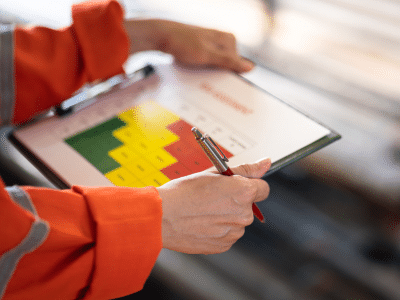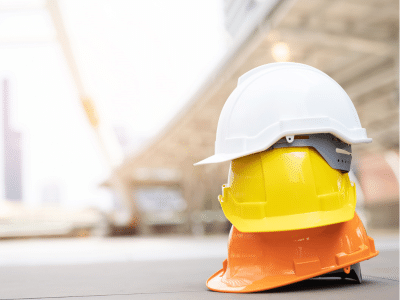Hard hats are a fundamental aspect of Personal Protective Equipment (PPE) on nearly every construction site in the UK. They are crucial for protecting workers against head injuries. The Health and Safety Executive (HSE) regulates the use of hard hats under the Personal Protective Equipment at Work Regulations. These regulations ensure that head protection is provided whenever there is a risk of injury.
For employees, this means wearing a hard hat is mandatory in areas where there’s a potential for hazards from falling or flying objects, or from striking against fixed objects.
The standards for hard hats are precise and enforce a legal requirement for employers to ensure the safety helmets provided meet necessary safety standards. Hard hats must be in good condition, fit the wearer correctly, and not interfere with other safety equipment, such as ear defenders.
Legal Framework and Compliance
In the UK, PPE regulations have been established by the HSE to ensure your safety on construction sites. These laws require that suitable head protection be provided and used to mitigate the risk of head injury from falling objects or contact with fixed objects.
Under the current legislation, namely the Personal Protective Equipment at Work Regulations 1992, employers are responsible for providing employees with necessary safety helmets as part of the essential safety equipment.
The Employment Act 1989 specifies the legalities regarding head protection in the workplace. Notably, turban-wearing Sikhs are exempt from any legal requirement to wear a safety helmet on construction sites, per Section 11(1) as amended by Section 6 of the Deregulation Act 2015.
This exception highlights the importance of respecting religious beliefs while balancing safety considerations. Nonetheless, if you’re a turban-wearing Sikh, it is still mandatory for you to use other PPE to ensure your overall safety.
As per the HSE, industrial safety helmets must meet the EN 397 standard, which includes rigorous tests for impact resistance, electrical hazards, and other dangers commonly encountered in construction work. Selecting the appropriate head protection is a critical element of your site risk assessment, which must be conducted thoroughly to protect workers on site.
Remember, if you are managing or overseeing work at a construction site, it is your legal obligation to ensure that everyone, including self-employed workers, wear hard hats if the risk assessment indicates a potential risk of head injuries.
Risk Assessment and Safety Management
Managing workplace safety is a vital component of any construction project. A thorough risk assessment is the backbone in identifying potential dangers while implementing safety measures is crucial to protect workers from injury.

Identifying Hazards
Risk assessment on construction sites involves a systematic examination of all aspects of work that could lead to a head injury or other potential risks. You — as a site manager or safety inspector — should walk through the site to detect any hazards such as risk of falling objects, fixed objects that may cause injury, or electrical hazards.
The HSE mandates that almost all construction sites conduct a site risk assessment to determine the severity and likelihood of these hazards. This includes:
- Hierarchy of control measures – Evaluate and prioritise controls based on their effectiveness.
- Legal requirement – It’s your responsibility to comply with the Personal Protective Equipment Regulations and the Management of Health and Safety at Work Regulations 1999.
Implementing Safety Measures
Once hazards are identified, the next step is to implement safety measures to mitigate risks, focusing on reducing the residual risk to the lowest practicable level. Providers of PPE must ensure that items like hard hats protect workers as per safety standards.
Hard hats are the first line of defence against head injuries and a legal necessity on UK construction sites. Other PPE, which may include safety equipment like ear defenders and eye protection, should complement hard hat regulations.
Requirements for Hard Hats
Hard hats are an essential component of PPE on construction sites, designed to offer protection against head injuries from falling objects and impacts with fixed objects. The HSE sets forth regulations to ensure your safety in the workplace.
Types and Specifications
To adhere to UK hard hat regulations, a helmet must pass these mandatory tests, which include:
- Impact Resistance: The helmet’s capacity to absorb shock from a falling object.
- Penetration Resistance: The helmet’s ability to withstand objects piercing through it.
- Chinstrap Strength: The ability to keep the helmet in place during work activities.
Suitable Head Protection
To ensure your head protection is suitable, it must:
- Fit properly: It should be comfortable and secure on your head to not impede your work or safety.
- Be in good condition: Regularly check for cracks, degradation, or damage that could compromise its protective function.
- Allow for other protective equipment: It should be compatible with other PPE, such as safety glasses.
Colour Coding and Markings
Colour coding on construction sites can help you quickly identify the roles of site colleagues. As per the new colour scheme introduced by Build UK:
- Black: Indicates site supervisors.
- White: Worn by site managers and competent operatives.
- Blue: Often used for trainee/intern site engineers, technical operators.
- Green: Designates safety inspectors or new workers without specific roles.
- Orange: Typically denotes slingers/signallers.
- Red: Used for fire marshals.
- Purple: Assigned to vehicle marshals.

Furthermore, safety helmets may feature reflective markings for better visibility or specific stickers denoting the worker’s skills or qualifications.
Use and Maintenance of Hard Hats
Proper use and consistent maintenance are fundamental to ensuring hard hats function effectively as PPE. This section covers how you should use, inspect, maintain, replace, and dispose of hard hats to comply with HSE guidelines.
Proper Usage
Your hard hat is your first line of defence against head injuries on construction sites. Always wear it with the brim forward to shield your face from falling objects. To ensure maximum protection required, adjust the suspension system so the hard hat fits snugly and sits level on your head.
Inspection and Maintenance
Daily checks should be carried out before wearing hard hats. Look for cracks, dents, or any damage that might compromise impact resistance.
The suspension system inside should also be inspected for signs of wear. If the hard hat has been struck by a significant force or fallen object, you must replace it immediately, even if no visible damage is apparent.
- Cleaning: Use mild soap and warm water, rinse thoroughly, and dry before use.
- Stickers: Placement of stickers should not cover damage and should be kept a minimum to allow regular inspection of the shell for cracks.
Replacement and Disposal
Hard hats must be replaced if they show signs of damage or after a significant impact. Follow manufacturer’s recommendations for replacement periods, typically every 2-5 years.
Upon replacement, don’t throw a used hard hat into general waste. Options include recycling programs or specialised waste management services that handle industrial safety helmets.
Always purchase replacement hard hats from a reputable supplier to ensure they meet the safety standards set by the HSE and are capable of passing the mandatory tests for industrial hard hats.
Roles and Responsibilities
Your role in maintaining health and safety on construction sites is crucial, particularly concerning hard hat regulations. If you are an employer or self-employed, the Personal Protective Equipment at Work Regulations 1992 is your starting point.
This mandates that you provide suitable PPE, including safety helmets, to all workers who are at risk of head injury. As a site manager, you are responsible for carrying out a site risk assessment to determine hazards that might lead to head injuries, such as falling objects or collisions with fixed objects.
Following this, you must ensure that suitable head protection is worn by anyone on site, including visitors. For construction workers, your responsibility includes wearing head protection as required and ensuring that it is worn correctly.
Remember, the same requirement applies to site supervisors and other technical operatives such as earth moving and vehicle marshals. Should an accident occur, the HSE may investigate whether the regulations were adhered to, and suitable head protection was provided and used. Self-employed workers must also comply with these regulations to the same extent as employees.
Frequently Asked Questions
Still not sure about HSE hard hat regulations in the UK? Here are some of the most commonly asked queries.
What are the current legal requirements for wearing hard hats on UK construction sites?
In the UK, the law requires head protection on construction sites to prevent risk of head injury. Workers must wear suitable head protection, and this is dictated by the Personal Protective Equipment Regulations 1992 and subsequent amendments.
Almost all construction sites require hard hats due to the high-risk nature of the work involved.
How often should safety helmets be inspected and replaced in accordance with HSE guidelines?
Safety helmets should be regularly inspected for any signs of wear and tear or damage and should be replaced if they are no longer in good condition.
The HSE does not specify exact time frames for helmet replacement, so this often falls to site managers to ensure they are replaced before they become ineffective.
Are there specific circumstances under which hard hats become mandatory on a UK worksite?
Hard hats become mandatory where the risks of head injury as seen by the site risk assessment fall under legislation. This includes risks from falling objects, impact with fixed objects, or even electrical hazards.
Site supervisors are responsible for determining when and where head protection is required based on the assessed risks.
Final Thoughts on HSE Hard Hat Regulations
All in all, it’s crucial to wear hard hats, both to protect your employees, yourself, and additional stakeholders, including visitors. Moreover, it’s important to follow the relevant legal policies and requirements, including colour-coding and sizing.
That said, conventional hard hats might look dull and generic for you and your workers. Don’t worry, Essential Workwear can make you branded PPE that makes your company uniform stand out from the crowd. From custom hi-vis clothing to embroidered workwear, we can personalise it to your liking.

